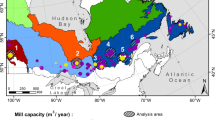Abstract
Three bioclimate variables (growing degree days after budburst, temperature of the coldest month and a moisture index) are used in a model (STASH) to predict potential range limits of north European tree species. CO2-induced climate warming scenarios cause major changes in these limits. The dominant conifers of the mixed conifer/northern hardwoods zone, Picea abies and Pinus sylvestris, retreat from the south and west while Fagus sylvatica and other temperate hardwoods spread to the north. A gap model (FORSKA 2) is used to simulate the associated transient responses of a forest reserve within this zone. In both dry Pinus- and moist Picea- dominated forest communities, Picea continues to increase while Pinus sooner or later declines. These changes are continuing successional (non-climatic) responses to the cessation of disturbance 150 years ago. Climate warming speeds up the succession, and allows Fagus to establish and increase. The eventual decline of Picea however is delayed due to the persistence of old-growth stands. Picea forests subject to continuing disturbance show a more rapid shift to dominance by Fagus and other temperate hardwoods. Delayed immigration of new species, including Fagus, would favour earlysuccessional species such as Betula pendula and Quercus spp. in a forest with reduced biomass and diversity. The results emphasise the complex and sometimes counter-intuitive nature of transient responses, and the importance of considering disturbance history and potential migration rates when predicting the impacts of rapid climate change on forests.
Similar content being viewed by others
References
Botkin, D. B., Janak, J. F., and Wallis, J. R.: 1972, ‘Some Consequences of a Computer Model of Forest Growth’, J. Ecol. 60, 849–873.
Bradshaw, R. H. W. and Zackrisson, O.: 1990, ‘A Two Thousand Year History of a Northern Swedish Boreal Forest Stand’, J. Veg. Sci. 1, 519–528.
Desanker, P. V. and Prentice, I. C.: 1995, ‘Modelling Vegetation Dynamics of Miombo Woodlands under Changing Climatic Conditions’, in Pernetta, J., Leemans, R., Elder, D., and Humphrey, S. (eds.), The Impact of Climate Change on Ecosystems and Species: Terrestrial Ecosystems, IUCN, pp. 23–38.
Huntley, B. and Prentice, I. C.: 1993, ‘Holocene Vegetation and Climates of Europe’, in Wright, H. E. Jr, Kutzbach, J. E., Webb III, T., Ruddiman, W. F., Street-Perrott, F. A., and Bartlein, P. J. (eds.), Global Climates since the Last Glacial Maximum, University of Minnesota, Minneapolis, pp. 136–168.
Hutchinson M. F.: 1989, ‘A New Objective Method for Spatial Interpolation of Meteorological Variables from Irregular Networks Applied to the Estimation of Monthly Mean Solar Radiation, Temperature, Precipitation and Windrun. Need for Climatic and Hydrologic Data in Agriculture in South-East Asia’, 89/5, CSIRO, Canberra, pp. 95–104.
Jalas, J. and Suominen, J.: 1972–1991, Atlas Florae Europaeae: Distribution of Vascular Plants in Europe, 1–9, Akateeminenl Kirjakauppa, Helsinki.
Lauenroth, W.: 1996, ‘Application of Patch Models to Examine Regional Sensitivity to Climate Change’, Climatic Change 34, 155–160 (this issue).
Leemans, R.: 1992, ‘Simulation and Future Projection of Succession in a Swedish Broad-Leaved Forest’, For. Ecol. Manage. 48, 305–319.
Leemans, R. and Cramer, W.: 1991, ‘The IIASA Climate Database for Mean Monthly Values of Temperature, Precipitation and Cloudiness on a Terrestrial Grid’, RR-91–18, IIASA, Laxenburg, Austria.
Lindbergh, G. and Lindquist, A-M.: Inventering av vegetation och skogstillstånd i Norra Kvill. Internrapport 2, Statens naturvårdsverk, SLU, Uppsala.
Murray, M. B., Cannell, M. G. R, and Smith, I.: 1989, ‘Date of Budburst of Fifteen Tree Species in Britain Following Climatic Warming’, J. Appl. Ecol. 26, 693–700.
Prentice, I.C. and Helmisaari, H.: 1991,‘Silvics of North European Trees: Compilation, Comparisons and Implications for Forest Succession Modelling’, For. Ecol. Manage. 42, 79–93.
Prentice, I. C. and Leemans, R.: 1990, ‘Pattern and Process and the Dynamics of Forest Structure: A Simulation Approach’, J. Ecol. 78, 340–355.
Prentice, I. C., Sykes, M. T., and Cramer, W.: 1991, ‘The Possible Dynamic Response of Northern Forests to Global Warming’, Global Ecol. Biogeogr. Lett. 1, 129–135.
Prentice, I. C., Sykes, M. T., and Cramer, W.: 1993, ‘A Simulation Model for the Transient Effects of Climate Change on Forest Landscapes’, Ecol. Modelling 65, 51–70.
Prentice, I. C., Cramer, W., Harrison, S. P., Leemans, R., Monserud, R. A., and Solomon, A. M.: 1992, ‘A Global Biome Model Based on Plant Physiology and Dominance, Soil Properties and Climate’, J. Biogeogr. 19, 117–134.
Price, D. T., Apps, M. J., Kurz, W. A., Prentice, I. C., and Sykes, M. T.: 1994, ‘Simulating the Carbon Budget of the Canadian Boreal Forest Using an Integrated Suite of Process-Based Models’, in Chhun-Huor Und (ed.), Forest Growth Models and their Uses, Canadian Forest Service, pp. 251–64.
Sakai, A. and Weiser, C. J.: 1973, ‘Freezing Resistance of Trees in North America with Reference to Tree Regions’, Ecology 54, 118–126.
Shugart, H. H.: 1984, A Theory of Forest Dynamics, Springer, New York, 278 pp.
Stephenson, N. L.: 1990, ‘Climatic Control of Vegetation Distribution: The Role of the Water Balance’, Am. Natur 135, 649–670.
Sykes, M. T. and Prentice, I. C.: 1995. ‘Boreal Forest Futures: Modelling the Controls on Species Range Limits and Transient Responses to Climate Change’, Water, Air, Soil Pollution 82, 415–428.
Sykes, M. T. and Prentice, I. C.: 1996 ‘Carbon Storage and Climate Change in Swedish Forests: A Comparison of Static and Dynamic Modelling Approaches’, in Apps, M. J. and Price, D. T. (eds), Forest Ecosystems, Forest Management and the Global Carbon Cycle, NATO ASI Series 40, pp. 69–78, Springer-Verlag, Berlin.
Sykes, M. T., Prentice, I. C., and Cramer, W.: 1996. ‘A Bioclimatic Model for the Potential Distributions of North European Tree Species under Present and Future Climates’, J. Biogeogr., in press.
Woodward, F. I.: 1987, Climate and Plant Distribution, Cambridge University Press, Cambridge.
Woodward, F. I. and Williams, B. G.: 1987, ‘Climate and Plant Distribution at Global and Local Scales’, Vegetatio 69, 189–197.
Author information
Authors and Affiliations
Rights and permissions
About this article
Cite this article
Sykes, M.T., Prentice, I.C. Climate change, tree species distributions and forest dynamics: A case study in the mixed conifer/northern hardwoods zone of northern Europe. Climatic Change 34, 161–177 (1996). https://doi.org/10.1007/BF00224628
Issue Date:
DOI: https://doi.org/10.1007/BF00224628




